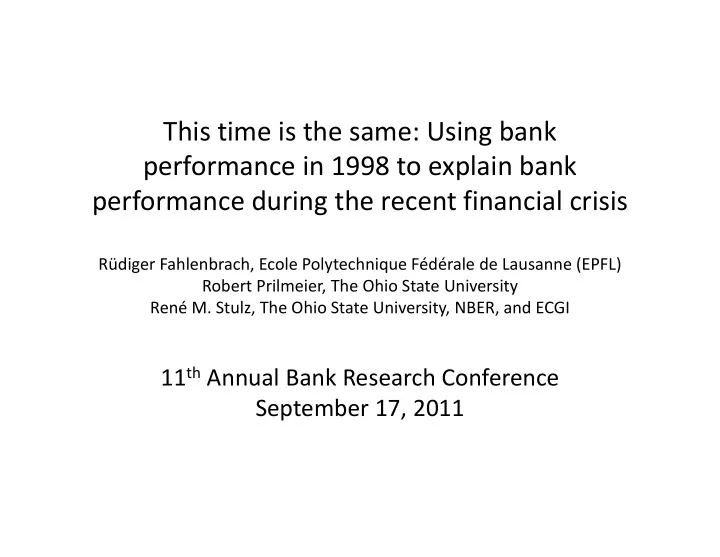

This time is the same: Using bank performance in 1998 to explain bank performance during the recent financial crisis Rüdiger Fahlenbrach, Ecole Polytechnique Fédérale de Lausanne (EPFL) Robert Prilmeier, The Ohio State University René M. Stulz, The Ohio State University, NBER, and ECGI 11 th Annual Bank Research Conference September 17, 2011
“The worst financial crisis in the last fifty years” Robert Rubin October 1998
Our paper How did banks that were affected more adversely by the financial crisis of 1998 do during the recent financial crisis ?
Our paper � We examine two hypotheses � Learning hypothesis : A bank’s bad experience in a crisis leads it to modify its business model or risk exposure so that it fares better in the next crisis � Business model hypothesis : A bank’s exposure in one crisis is the result of its business model that it is unwilling or unable to change so that a bank’s experience in one crisis is a good predictor of its experience in a subsequent one � against the null hypothesis that all crises are unique and that there is no correlation in bank performance across crises
Russian financial crisis 1998 � August 1998: Russian stock and bond markets collapse, Russia defaults on ruble-denominated debt, stops pegging ruble to dollar � September 23, 1998: Consortium of 12 banks bails out Long-Term Capital Management (LTCM) after large losses � Consequences: reassessment of sovereign risk, liquidity withdraws from markets, flight to quality
Our sample � 347 U.S. financial institutions that existed in 1998 and 2006 with same Compustat or CRSP identifier � 18 non-depository institutions � 26 failures during the financial crisis (closed by FDIC, chapter 11, merger at a discount, or forced delisting)
Key dependent and independent variables � Dependent variables: � Buy-and-hold returns from July 1, 2007 to December 31, 2008 � Bank failure (yes/no) � Independent variables: � Return during crisis of 1998, defined as return from first trading day in August 1998 to lowest stock price in 1998 � Six-month rebound return
Table 2 – Buy-and-hold returns during the financial crisis and returns during the crisis of 1998 (1) (4) (5) Economic magnitude: Crisis return 1998 0.6550*** 0.4895*** 0.4409*** One std decrease in (4.73) (3.11) (2.59) 1998 returns (0.125) Rebound return 1998 0.0535 -0.0122 -> 610 basis points (0.66) (-0.11) lower annualized Return in 2006 -0.2591** -0.2023* returns during (-2.55) (-1.77) 2007/2008 Book-to-market -0.1847 -0.3627*** (-1.54) (-3.25) One std increase in Log (market value) -0.0488*** -0.0194 2006 leverage (-4.11) (-1.44) -> 700 basis points Beta 0.1195*** 0.0887** lower annualized (3.10) (2.16) returns during Leverage -0.0206*** 2007/2008 (-3.28) Tier 1 capital ratio 0.0192*** (2.81) Number of observations 347 345 318 R-squared 0.06 0.16 0.13
Additional findings � Effect is driven by the quintile of poorest performers in 1998 � Effect is concentrated in large banks (larger than sample median) � No evidence that the effect is different for banks that had the same CEO in 1998 and 2006
Table 7 – predicting bank failure (4) (5) Economic magnitude: Crisis return 1998 -0.3994*** -0.3453*** One std decrease in (-4.04) (-3.47) 1998 returns (0.125) Rebound return 1998 -0.1404*** -0.1369** -> 5.0% higher failure (-2.74) (-2.15) probability during 2007- Return in 2006 0.0110 -0.0316 2009 (0.18) (-0.45) Book-to-market 0.0264 0.0455 Very large relative to (0.35) (0.73) unconditional failure 0.0226*** 0.0156** Log (market value) probability of 7.5% (3.37) (2.24) Beta -0.0052 -0.0000 (-0.22) (-0.00) Leverage 0.0047 (1.41) Tier 1 capital ratio -0.0024 (-0.53) Number of observations 345 318
Discussion of results � Shown evidence in support of the business model hypothesis � What can explain this finding? � Analyze firms that were bottom tercile performers both in 1998 and in 2007/2008 � Characteristics we analyze: � Leverage and short-term funding � Asset growth during 3 years prior to crisis � Income from non-traditional sources
Probit regressions predicting membership in the bottom performer group (Table 9, excerpt) (3) (4) Short-term funding 0.6524*** 0.6033*** (2.75) (2.63) Asset growth 0.3452** 0.2922** (2.44) (2.15) Investment securities -0.6184*** -0.5437*** (-3.95) (-3.55) Assets held for sale -0.4039 -0.1760 (-0.83) (-0.38) Trading securities -1.2327 -0.2369 (-1.06) (-0.31) Income variability -7.6055 1.7938 (-0.53) (0.15) Non-interest income -0.3801*** (-2.71) Leverage 0.0156* 0.0157** (1.88) (2.01) Other firm controls Yes Yes Number of observations 297 297
More evidence for business model hypothesis � These results suggest that correlation between 1998 crisis returns and 2007-2008 crisis returns is at least partly due to a business model that relies on � higher leverage � more short-term funding � stronger asset growth during the boom preceding a crisis � If our interpretation is correct, we should expect to find that returns during the 1998 crisis predict the levels of these firm characteristics in 2006 � We find that this is the case
Robustness � Results are robust to � Truncating, winsorizing, estimating median regressions � Measuring returns and betas over different horizons � Estimating market-model adjusted returns � Including marginal expected shortfall (Acharya et al., 2010) � Placebo regressions show that � Returns during August – October 1997 do not explain financial crisis returns � Crisis returns in 1998 do not explain returns during 2005 - 2006
Conclusion � Main result: Stock market performance of banks during the 1998 financial crisis predicts the stock market performance of banks during the financial crisis of 2007/2008 � Effect economically large � Puts into perspective some of the recent explanations of the crisis � Find evidence on heavy reliance on short term funding and leverage, and rapid asset growth in firms that are poor performers in both 1998 and 2007/2008 � Further research necessary to isolate aspects of a firm’s business model or risk culture that can explain this predictability
Recommend
More recommend